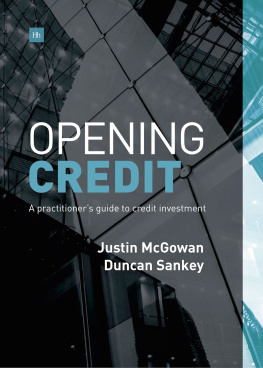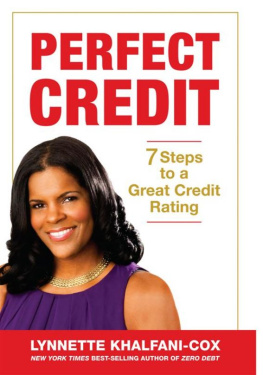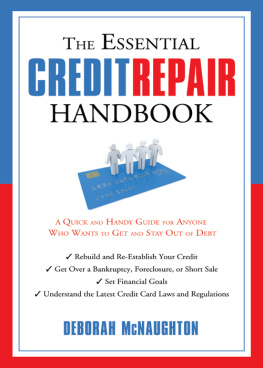5. Behind the Numbers: Adjusted Debt and Liquidity
About the Authors
Justin McGowans career in finance spans 25 years. His analytical experience covers the full range of the capital structure, in both equity and credit instruments and he has worked on the sell- and buy-sides in disciplines ranging from bank loans, corporate bonds, emerging market equities, long/short equity and credit hedge funds, long-only funds and synthetic credit products. After an early apprenticeship in corporate finance, spent largely in Southern European markets, he moved on to work at a major credit ratings agency in New York and London, where he focused on the energy sector and subsequently on Germanys Mittelstand issuers across a wide range of industries.
Thereafter, he became an I.I.-rated emerging markets equity analyst and director of research, working principally out of New York, Mexico City and Rio de Janeiro. Returning to England in 2001, he re-entered the world of credit, where he has worked ever since. He has advised on investments in corporations and parastatal entities in the financial, manufacturing, energy, natural resources, retailing, consumer, healthcare and media sectors globally.
Justin has an MA in Medieval and Modern Languages from St Edmund Hall, Oxford. He is a holder of the Investment Management Certificate. He lives in Surrey with his wife and two daughters.
Duncan Sankey has 27 years experience in credit investment and lending in a career spanning commercial and investment banking, a leading ratings agency, the origination and management of sell-side research teams and, most recently, fund management, including investment in alternative strategies and structured corporate credit. His analytical experience has covered the full gamut from financials and corporates (utilities, autos and suppliers, industrials, leisure, consumer products, transportation and real estate) to sovereigns, supra-sovereigns and parastatals. His experience of credit analysis and investment encompasses both established and emerging markets (particularly those of Asia and Eastern Europe) and he has worked in London, New York and Atlanta.
As a practitioner of credit in the wake of the corporate scandals during the first few years of the millennium, he became increasingly interested in the role played by corporate governance. This led him to pursue studies in the topic in the academic arena, where he has written on such matters as the bond markets failure to adopt standardised comprehensive bond covenants and contributed to published academic research on governance, regulation and financial market instability and its impact on policy. Duncan has written on credit issues for trade journals, discussed them on financial TV and often presents on credit matters to industry conferences. He is an associate of the London Centre for Corporate Governance and Ethics and a member of the Examinations and Education Committee of the Chartered Financial Analyst Society UK.
Duncan has an MSc in Corporate Governance and Ethics from the University of London and an MA in Medieval and Modern Languages from St. Edmund Hall, Oxford. He lives in London with his wife and daughter.
The authors have worked together for over 20 years. Since 2005 and 2003, respectively, Justin and Duncan have both worked in the award-winning corporate credit team of Cheyne Capital Management, one of Europes leading alternative credit managers, participating in the management of both long-biased and long/short credit strategies specialising in global investment-grade and crossover corporate credit. Cheynes long-only corporate credit funds have compounded at approximately 17% per annum since 2002 and have recorded cumulative default losses of only 0.34% over that period, despite navigating some of the worst market conditions ever experienced.
Preface
What is this book about?
T his book has its genesis in three important problems in the world of investing in credit. It is written to help solve them, and to that end brings to bear our experience in investment in general, and in the credit markets in particular.
The first problem is that much of the work available on investment in both credit and equity is quantitative in its focus. Without in any way seeking to diminish the importance of quantitative analysis, it strikes us that success in selecting investments that yield above-market returns and in avoiding investments that materially underperform and possibly default, depends on understanding the strategies that led to the quantitative output. Those strategies do not emerge from the ether but are the product of individual decisions. The focus of the investor should therefore be on identifying the persons responsible for the decisions and understanding their motives and the factors underlying their decision-making. Our goal, then, is to return the analysis of human factors to the centre stage of investment evaluation.
The second problem is that any analysis that focuses on the human elements of the corporation must also evaluate the rules that regulate how those humans interact and relate to their investors (i.e. corporate governance). However, for most investors this has been reduced to a box-ticking exercise. We champion a more holistic approach to finding the holes in the corporate structure, something we believe is of paramount importance for credit investors, since while they may rarely use it shareholders at least have the nuclear trigger of being able to fire the managers that steward their assets. Credit investors can only fall back on the contractual rights that they have been able to negotiate; they are stuck with the management and, hence, need to understand at the most fundamental level how managements actions are regulated.
The third and final problem is that much work on credit analysis seems to treat it as simply an adjunct to equity analysis. This is both misleading and simplistic. Often the desires of equity and credit investors and the strategies they pursue are in conflict. Whereas the equity market is, we would argue, more or less efficient and most equities of an individual corporation are fungible, the same is simply not true of credit. The credit market is far from efficient in the generally accepted sense of the term it has increasingly patchy liquidity, multiple traded asset classes with widely differing claims on the assets of the corporation in the event of a bankruptcy and highly idiosyncratic characteristics affecting their relative pricing. In addition to differences in claims, differences in maturity also ensure that credit instruments of the same entity are rarely fungible. These variances affect the valuation of the underlying securities to a profound degree and must be clearly identified in order to determine where, if anywhere, value exists. Thus, while investors might have a solid grasp of fundamental corporate analysis, they will be unlikely to succeed in credit investing without an equally robust understanding of the technical issues pertaining to credit. We will attempt to outline some of the factors that matter.
The ratings agencies have published their own methodologies for assessing credit risk, and publications of an academic nature detail the more quantitative side of the discipline, along with the mathematical aspects of portfolio risk. However, there are few options available when setting out into a field which remains, relative to other investment options, somewhat obscure. We hope to address this in the coming chapters, tying the thematic and theoretical elements of the book into a selection of factual case studies from the recent past.
This book, then, is intended for readers who already have some awareness of corporate credit as an asset class but are not themselves seasoned credit practitioners. In our view, this group is fairly wide-ranging and diverse, and includes:











